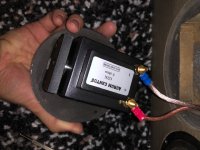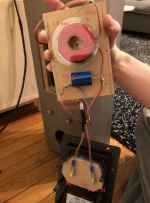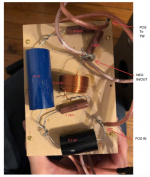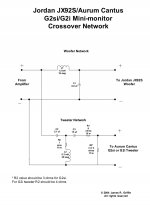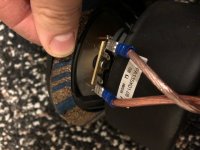I built a pair of floorstanders based on Jim’s design pack. I’ve never been satisfied with the sound in the cross over range. Voices sound muffled and the overall sound isn’t engaging. Based on all of the rave reviews I know it’s something I’ve done, but I can’t seem to find out what. I currently have then running through a pioneer elite VSX-92TXH which allows me parametric EQ control through their MCACC technology.
I think the error is in the crossover, but I have triple checked the wiring and it looks exactly like what I am seeing on the design. I have uploaded photos of the crossover (this was one of the first crossovers I wired, please excuse the mess), speakers, and what the EQ has to be set at for them to be open and “flat”.
I am hoping someone can help me figure out what I’ve done wrong!
Other info: speakers are about two feet from the wall, 7 feet apart, and 7 feet from the listening position.
I think the error is in the crossover, but I have triple checked the wiring and it looks exactly like what I am seeing on the design. I have uploaded photos of the crossover (this was one of the first crossovers I wired, please excuse the mess), speakers, and what the EQ has to be set at for them to be open and “flat”.
I am hoping someone can help me figure out what I’ve done wrong!
Other info: speakers are about two feet from the wall, 7 feet apart, and 7 feet from the listening position.
Attachments
-
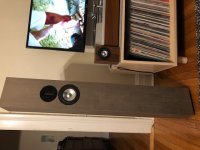 D0FECCA8-0D25-4D86-A336-ACD0DB75B192.jpeg83.8 KB · Views: 183
D0FECCA8-0D25-4D86-A336-ACD0DB75B192.jpeg83.8 KB · Views: 183 -
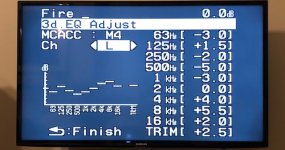 1CFFD43D-A3CD-4C9E-9046-775B71F971DF.jpeg81.7 KB · Views: 180
1CFFD43D-A3CD-4C9E-9046-775B71F971DF.jpeg81.7 KB · Views: 180 -
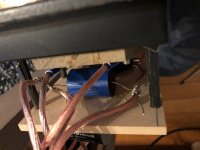 908290F3-4827-41EF-A63D-C144C6902D5D.jpeg74.2 KB · Views: 179
908290F3-4827-41EF-A63D-C144C6902D5D.jpeg74.2 KB · Views: 179 -
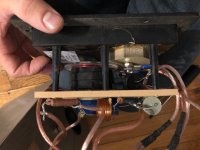 B847211B-39BA-4887-9B7B-BB7B82A6F540.jpeg94 KB · Views: 178
B847211B-39BA-4887-9B7B-BB7B82A6F540.jpeg94 KB · Views: 178 -
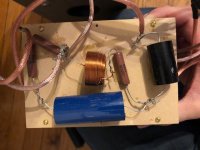 379AECDC-40DA-46E2-83E7-2567F29B5906.jpeg88.5 KB · Views: 176
379AECDC-40DA-46E2-83E7-2567F29B5906.jpeg88.5 KB · Views: 176
The wiring looks too messy to easily confirm it's withouot faults, especially woofer part, and the lack of wire designations. But, if you are confident nothing is wrong with it, then there is individual parts that may be out of spec or completely wrong. I can see the resistors are Mills, the R value is not visible. Check the padding resistors by measuring out of circuit for the correct values. Is there a schematic? Everything ok with passive electronics, then there is the tweeter. Check its health status. You have applied considerable tweeter EQ boost, a sign that Lpad may be wrong somehow, or the unit.
I cleaned up the images and added labels. I checked the values on everything and they line up. I agree there is certainly something off with the attenuation.
I will borrow a pair of calipers from work to double check the wire gauge to make sure I am not out of spec on my inductors. I will also check all resistor values with a multimeter to make sure they are in spec.
The only other last ditch effort I can think of is to really go after the chamfer on the inside of the box behind the Jordan driver. It currently has a round over, but the Jordan drivers don't have a lot of breathing room with their basket design. Is it possible that they are being choked a little causing mechanic resistance which in turn is becoming electrical resistance in the circuit and throwing off the whole cross over?
I will borrow a pair of calipers from work to double check the wire gauge to make sure I am not out of spec on my inductors. I will also check all resistor values with a multimeter to make sure they are in spec.
The only other last ditch effort I can think of is to really go after the chamfer on the inside of the box behind the Jordan driver. It currently has a round over, but the Jordan drivers don't have a lot of breathing room with their basket design. Is it possible that they are being choked a little causing mechanic resistance which in turn is becoming electrical resistance in the circuit and throwing off the whole cross over?
Attachments
I still have 4 of the Jordan with a ribbon speakers (2 mini-monitors and 2 MLTL versions) which use the original crossover networks as you posted. These have been in operation for up to 15 years and still sound great.
First concern is whether you have the same problem with both speakers in your pair. Have you tried to listen to each speaker independently (listen in mono not stereo mode) to verify that both speakers have the same problem with its sound? If both speakers have the same problem, then I would assume that you have an common issue with both crossovers of your pair.
If needed, you will have to trouble shoot your crossover assembly to ascertain what might be wrong. I suggest that you first start with tracing the network connections. Begin with a clean frame of mind. Make no assumptions about any of the connections or parts. I recommend that you begin with a copy of the crossover diagram and mark with a highlighter each wire as you carefully point-to-point track its path. Verify the polarity of each connection (especially the connections to the source and drivers). I'm concerned about your use of wiring that doesn't allow clear identification of each wire within the assembly. For my crossovers and speaker cables I use colored wires which aids in tracking circuit paths. Certify the marked value of each component as you go. Especially check the value of the resistors.
Hopefully, you will be able to identify the issue and correct your crossovers as the speakers really sound sweet when right.
Finally, while chamfering the inside cutouts would slightly improve the sound of a functioning speaker your current issue is more systemic than these cutouts. Get the crossover correct and then determine whether the sound is good enough.
First concern is whether you have the same problem with both speakers in your pair. Have you tried to listen to each speaker independently (listen in mono not stereo mode) to verify that both speakers have the same problem with its sound? If both speakers have the same problem, then I would assume that you have an common issue with both crossovers of your pair.
If needed, you will have to trouble shoot your crossover assembly to ascertain what might be wrong. I suggest that you first start with tracing the network connections. Begin with a clean frame of mind. Make no assumptions about any of the connections or parts. I recommend that you begin with a copy of the crossover diagram and mark with a highlighter each wire as you carefully point-to-point track its path. Verify the polarity of each connection (especially the connections to the source and drivers). I'm concerned about your use of wiring that doesn't allow clear identification of each wire within the assembly. For my crossovers and speaker cables I use colored wires which aids in tracking circuit paths. Certify the marked value of each component as you go. Especially check the value of the resistors.
Hopefully, you will be able to identify the issue and correct your crossovers as the speakers really sound sweet when right.
Finally, while chamfering the inside cutouts would slightly improve the sound of a functioning speaker your current issue is more systemic than these cutouts. Get the crossover correct and then determine whether the sound is good enough.
Last edited:
SOLVED! It kept all of the wiring of the crossovers and rearranged the inductors so they were on opposite ends of the board with better alignment to each other. Now they sound as amazing as everyone has been saying!
- Status
- Not open for further replies.
